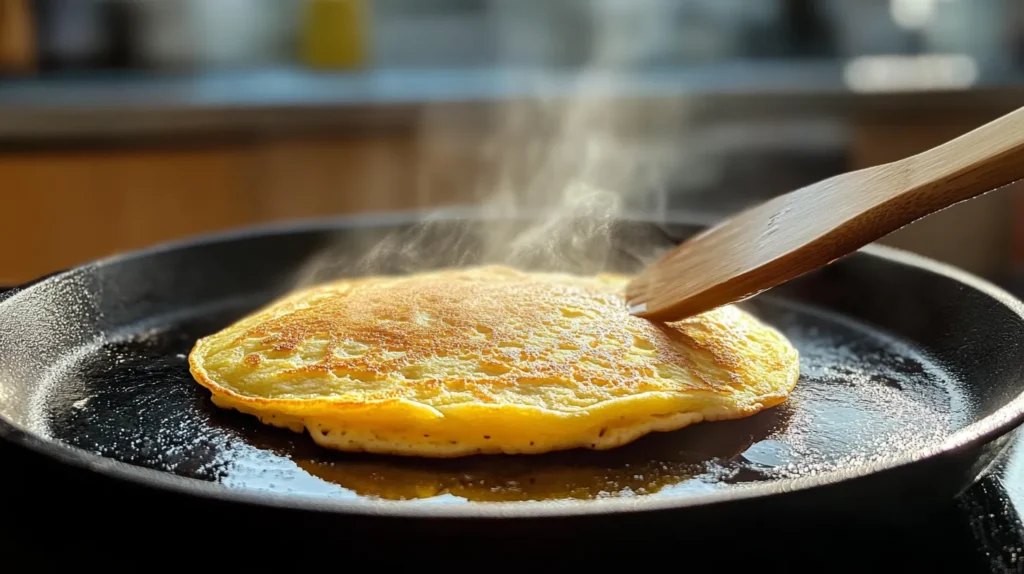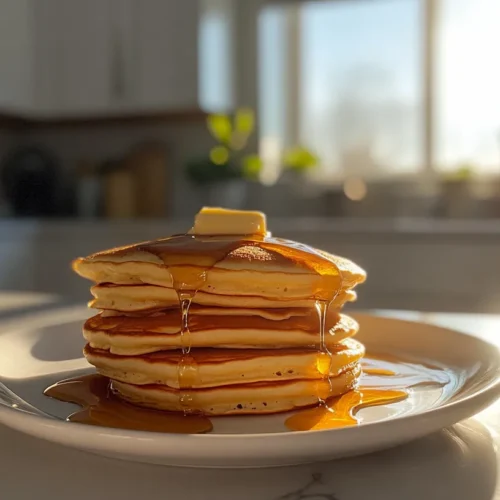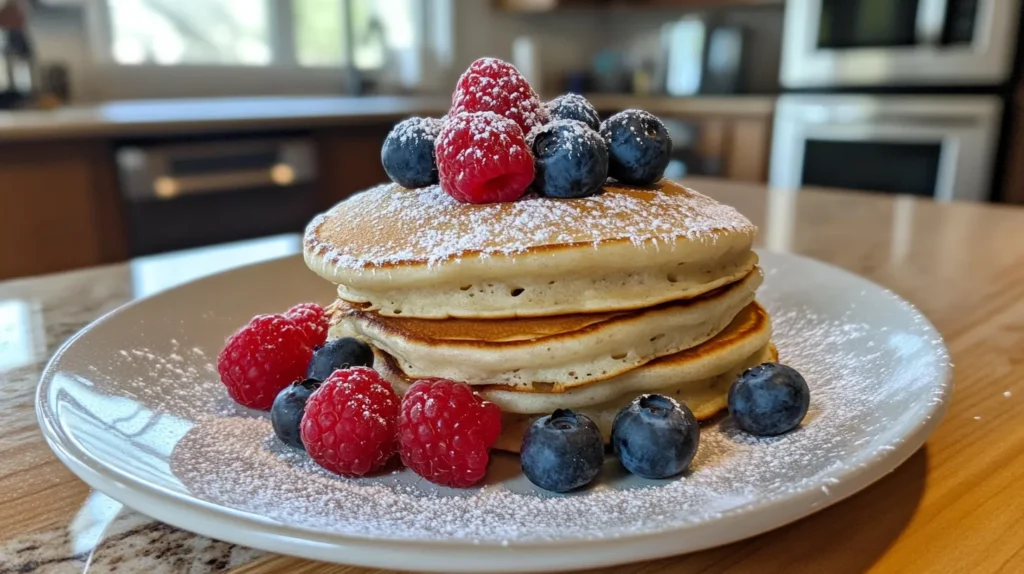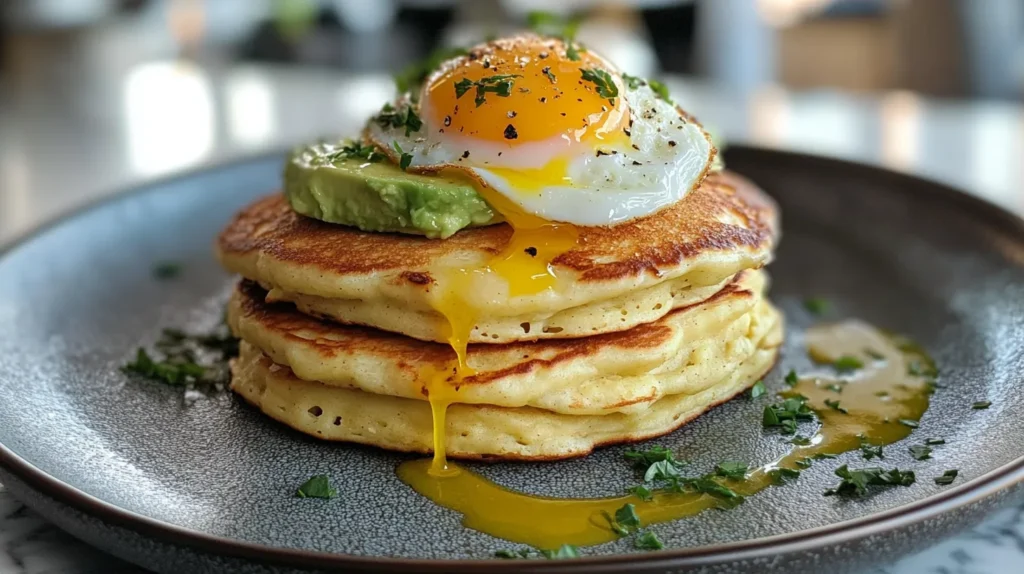Table of Contents
Fluffy pancakes are the ultimate comfort food and a breakfast staple loved around the world. Whether you enjoy them with syrup, fruit, or just butter, a perfectly light and airy pancake can transform your morning meal. But achieving that soft, cloud-like texture isn’t just about mixing ingredients together—it’s about understanding the science behind the fluffiness.
In this guide, we’ll uncover the secrets to making the best fluffy pancakes, from choosing the right ingredients to mastering cooking techniques. Whether you’re a beginner or a seasoned cook, these tips will help you make pancakes that are golden, airy, and absolutely delicious.
The Science Behind Fluffy Pancakes
Achieving the perfect fluffy pancake isn’t just about following a recipe—it’s about understanding how ingredients and techniques work together. Fluffiness comes from the right combination of leavening agents, mixing methods, and cooking temperature. Let’s break down the key elements that contribute to the light and airy texture of pancakes.
Role of Ingredients in Fluffiness
Every ingredient in pancake batter plays a specific role in creating the ideal texture. Here’s how they contribute to fluffiness:
- Flour: Provides structure to the pancakes. Using all-purpose flour with the right protein content (8-10%) helps create a soft texture without making the pancakes too dense.
- Eggs: Act as a binding agent and add moisture. They also help incorporate air into the batter when whisked properly.
- Leavening Agents (Baking Powder & Baking Soda): These create air bubbles that expand when heated, leading to fluffy pancakes.
- Buttermilk or Milk: The acidity in buttermilk reacts with baking soda to create extra lift, making pancakes even softer.
- Fat (Butter or Oil): Adds moisture and richness, preventing dryness.
- Sugar: Not only adds sweetness but also helps with caramelization, giving pancakes a golden-brown color.
Mixing Techniques for the Best Texture
How you mix your pancake batter significantly affects the final texture. Over-mixing is one of the most common mistakes people make, leading to tough and chewy pancakes. Here’s how to do it right:
- Mix Dry and Wet Ingredients Separately – Combine dry ingredients in one bowl and wet ingredients in another before gently folding them together.
- Avoid Over-Mixing – Stir the batter just until there are no visible streaks of flour. A few lumps are okay! Over-mixing develops too much gluten, resulting in dense pancakes.
- Let the Batter Rest – Allowing the batter to sit for about 10-15 minutes lets the leavening agents activate, creating a fluffier texture.
Cooking Temperature and Timing
Even if you have the perfect batter, the way you cook pancakes determines whether they turn out light and airy or flat and dense.
- Preheat the Pan or Griddle: A medium-low heat is ideal. Too hot, and the pancakes will burn outside before cooking inside; too low, and they won’t rise properly.
- Test with a Drop of Water: A drop of water should sizzle but not evaporate instantly when it touches the pan—this signals the right temperature.
- Watch for Bubbles: Once bubbles appear on the surface and the edges start looking dry (around 2-3 minutes), it’s time to flip.
- Flip Gently: A quick, confident flip ensures minimal air loss, keeping pancakes fluffy.

Mastering these simple yet essential techniques will give you the perfect foundation for making soft, fluffy pancakes every time.
Pro Tips for Extra Fluffy Pancakes
Even with the perfect ingredients, small tweaks in your technique can make a huge difference in achieving the fluffiest pancakes. Follow these expert tips to elevate your pancake game.
1. Let the Batter Rest
Allowing the batter to rest before cooking is a game-changer for fluffy pancakes. Here’s why:
- It gives the flour time to absorb the liquid, creating a smoother texture.
- The baking powder has time to activate, leading to better rise.
- Air bubbles form in the batter, contributing to a lighter texture.
How long should you let the batter rest?
Ideally, 10-15 minutes is enough to let the ingredients work their magic.
2. Use the Right Cooking Tools
The equipment you use can impact how well your pancakes cook. Here are the best tools for the job:
- Griddle or Non-Stick Pan – A heavy, flat surface ensures even heat distribution.
- Ladle or Measuring Cup – Helps pour consistent-sized pancakes.
- Thin-Edged Spatula – Makes flipping easier without deflating the pancakes.
For best results, preheat your pan to medium-low heat before adding the batter.
3. Cook at the Perfect Temperature
Temperature plays a crucial role in achieving golden, fluffy pancakes. Too hot, and they’ll burn before cooking inside. Too low, and they won’t rise properly.
- Ideal heat setting: Medium-low to medium.
- Test the pan: Sprinkle a few drops of water; if they sizzle but don’t evaporate instantly, it’s ready.
Pro Tip: Avoid pressing down on the pancakes with a spatula—this deflates them and reduces fluffiness.
4. Flip at the Right Time
Knowing when to flip your pancakes is essential to keeping them airy. Follow these cues:
- Watch for bubbles – When bubbles appear on the surface and the edges start to look dry (about 2-3 minutes), it’s time to flip.
- Flip once only – Flipping multiple times deflates the pancakes.
- Be gentle – Use a thin spatula and flip in one smooth motion.
5. Avoid Over-Mixing the Batter
One of the biggest mistakes people make is over-mixing the batter, which leads to dense pancakes.
- Mix until just combined – Some lumps are okay!
- Use a gentle folding motion – Stirring too much activates gluten, making pancakes chewy instead of fluffy.
6. Separate and Whip Egg Whites (Optional)
For ultra-light pancakes, separate the egg whites and whip them before folding them into the batter.
- Whisk egg whites until soft peaks form
- Gently fold them into the batter without deflating them
This technique adds extra air pockets, creating incredibly soft and fluffy pancakes.
Common Pancake Mistakes and How to Fix Them
Even the most experienced cooks can run into pancake problems. If your pancakes are turning out flat, dense, unevenly cooked, or chewy, don’t worry—these common mistakes have easy fixes. Below are the most frequent issues and how to correct them.
1. Why Are My Pancakes Flat?
The Problem: Your pancakes don’t rise and stay thin instead of becoming fluffy.
Possible Causes & Solutions:
- Expired baking powder or baking soda → Always check the freshness of your leavening agents. If they’re old, they won’t create the bubbles needed for fluffiness.
- Too much liquid in the batter → If the batter is too runny, add a bit more flour to balance the consistency.
- Over-mixed batter → Stir just until combined. Over-mixing breaks down the air pockets that help pancakes rise.
2. How to Avoid Dense and Chewy Pancakes
The Problem: Instead of being light and airy, your pancakes feel heavy and tough.
Possible Causes & Solutions:
- Too much gluten formation → Over-mixing the batter develops too much gluten, making pancakes dense. Mix only until the ingredients are just combined.
- Not enough leavening agent → Make sure you’re using the correct ratio of baking powder to flour (typically 1 teaspoon per cup of flour).
- Using only milk instead of buttermilk → Buttermilk adds acidity, which reacts with baking soda to create extra fluff. If you don’t have buttermilk, add a teaspoon of vinegar or lemon juice to regular milk.
3. Why Are My Pancakes Dry?
The Problem: Your pancakes lack moisture and taste overly dry.
Possible Causes & Solutions:
- Not enough fat in the batter → Pancakes need butter or oil for moisture. Stick to the recommended amount in your recipe.
- Cooking at too low a temperature → Cooking too slowly dries out the pancakes before they can rise properly. Stick to medium-low to medium heat.
- Overcooking → Leaving pancakes on the heat too long removes moisture. Flip at the right time and cook only until golden brown.
4. How to Get Evenly Cooked Pancakes
The Problem: Some pancakes are burned while others are undercooked in the middle.
Possible Causes & Solutions:
- Uneven heat distribution → Use a non-stick griddle or a heavy-bottomed pan that distributes heat evenly.
- Cooking on high heat → Lower the temperature slightly and allow the pancake to cook fully on one side before flipping.
- Flipping too soon → Wait until bubbles form on the surface before flipping. Flipping too early results in an undercooked center.
5. Why Are My Pancakes Too Oily or Greasy?
The Problem: Pancakes absorb too much oil and taste greasy.
Possible Causes & Solutions:
- Too much oil or butter in the pan → Use a minimal amount, just enough to lightly coat the pan.
- Not wiping excess oil between batches → Too much leftover oil can make pancakes greasy. Wipe with a paper towel before pouring the next batch.
6. Why Do My Pancakes Have a Bitter Taste?
The Problem: Your pancakes taste slightly bitter instead of sweet and flavorful.
Possible Causes & Solutions:
- Too much baking soda or baking powder → Stick to the recommended amount. If the recipe calls for baking soda, balance it with an acidic ingredient like buttermilk.
- Burned pancakes → Cooking on too high heat can create a burnt, bitter taste. Keep the heat at a medium-low setting.
By avoiding these common mistakes and making small adjustments, you’ll consistently achieve fluffy, perfectly cooked pancakes every time.
Best Ingredients for the Fluffiest Pancakes
To achieve the perfect fluffy pancakes, the quality and type of ingredients you use matter just as much as the technique. Each ingredient plays a crucial role in the texture, rise, and taste of your pancakes. Let’s explore the best choices for each component to help you create the lightest, airiest pancakes possible.

Fluffy Pancake Recipe
Equipment
- 1 Mixing bowl for batter preparation
- 1 Whisk for mixing ingredients
- 1 Non-stick Skillet for cooking pancakes
- 1 Spatula for flipping pancakes
Ingredients
- 1 ½ cups all-purpose flour
- 3 ½ tsp baking powder
- 1 tbsp sugar
- ¼ tsp salt
- 1 ¼ cups milk
- 1 large egg
- 3 tbsp unsalted butter melted
- 1 tsp vanilla extract
- Cooking spray or additional butter for frying
Instructions
- In a large mixing bowl, whisk together flour, baking powder, sugar, and salt.
- In another bowl, whisk milk, egg, melted butter, and vanilla extract until well combined.
- Gradually add the wet ingredients to the dry ingredients, stirring gently until just combined. Do not overmix; a few lumps are fine.
- Let the batter rest for about 5 minutes to allow the baking powder to activate.
- Heat a non-stick skillet over medium heat and lightly grease with cooking spray or butter.
- Pour ¼ cup of batter onto the skillet for each pancake. Cook until bubbles form on the surface and the edges look set (about 2-3 minutes).
- Flip and cook for another 1-2 minutes until golden brown and cooked through.
- Repeat with the remaining batter, greasing the skillet as needed.
- Serve warm with butter, syrup, or your favorite toppings.
Notes
Choosing the Right Flour
Flour is the backbone of pancake batter, and using the right type ensures the best texture. Here are the best options:
- All-Purpose Flour – The most commonly used flour for pancakes, offering a balanced texture that is neither too dense nor too light.
- Cake Flour – Lower in protein than all-purpose flour, cake flour produces an ultra-soft and airy pancake.
- Self-Rising Flour – Contains baking powder, which can provide extra lift but may require adjustments to leavening agents in the recipe.
- Whole Wheat Flour – A healthier option but can make pancakes denser; best when mixed with all-purpose flour for a fluffier result.
For the fluffiest pancakes, a mix of all-purpose flour and cake flour (in a 2:1 ratio) provides structure while keeping the texture soft.
The Secret to Perfect Leavening
Leavening agents are responsible for creating the bubbles that make pancakes rise. Here’s what works best:
- Baking Powder – The primary leavening agent in most pancake recipes. It releases carbon dioxide when mixed with liquids and heat, causing pancakes to puff up.
- Baking Soda – Needs an acidic ingredient like buttermilk or yogurt to activate. Helps create a light texture but should be used in small amounts.
- Eggs – Not only add structure but also trap air when whisked properly, enhancing fluffiness.
- Whipped Egg Whites (Optional) – Folding in whipped egg whites separately can create extra-light and airy pancakes.
For the best rise, use fresh baking powder and combine it with buttermilk for an extra boost.
Liquid Ingredients: Buttermilk vs. Milk
The type of liquid you use can make or break your pancakes. Here’s how different options affect fluffiness:
- Buttermilk – The best choice for fluffy pancakes! Its acidity reacts with baking soda to create additional lift while making pancakes tender.
- Whole Milk – Works well, but doesn’t provide the same rise as buttermilk.
- Almond, Oat, or Soy Milk – Good dairy-free alternatives but may require an extra teaspoon of vinegar or lemon juice to mimic buttermilk’s effect.
For the fluffiest pancakes, use buttermilk or add a tablespoon of vinegar/lemon juice to regular milk to achieve a similar effect.
The Role of Fats: Butter vs. Oil
Fats contribute to both flavor and texture. Here’s the best way to use them:
- Melted Butter – Adds richness and a classic taste, but too much can make pancakes greasy.
- Vegetable or Canola Oil – Ensures moisture and prevents dryness but lacks the rich flavor of butter.
- A Combination of Both – Using melted butter in the batter and oil on the pan provides the best balance of flavor and texture.
By selecting the right flour, leavening agents, liquids, and fats, you’ll create pancakes that are soft, fluffy, and delicious every time.

Creative Toppings and Flavor Variations
While classic pancakes with butter and syrup are delicious, there are endless ways to elevate your pancakes with unique toppings and flavor combinations. Whether you prefer sweet, savory, or healthy options, here are some creative ways to customize your pancakes.
1. Classic vs. Unique Toppings
Traditional toppings are always a great choice, but why not experiment with something new? Here’s a mix of classic and unique pancake toppings:
| Classic Toppings | Unique Toppings |
|---|---|
| Maple syrup | Lemon curd |
| Butter | Matcha glaze |
| Fresh berries | Crushed pistachios |
| Whipped cream | Caramelized bananas |
| Chocolate chips | Peanut butter drizzle |
| Honey | Mascarpone cheese |
| Powdered sugar | Greek yogurt and honey |
For an extra indulgent twist, try stacking layers of different toppings between pancakes, creating a flavorful pancake tower.
2. Adding Flavors to the Batter
Enhancing the batter itself is a fun way to infuse new flavors into your pancakes before cooking. Here are some creative mix-ins:
- Spiced Pancakes – Add cinnamon, nutmeg, or pumpkin spice to the batter for a warm, cozy flavor.
- Citrus Zest – Lemon or orange zest brightens up pancakes with a fresh, tangy kick.
- Chocolate Lovers’ Pancakes – Mix in cocoa powder or chocolate chips for a rich, decadent treat.
- Coffee-Infused Pancakes – Add a shot of espresso or coffee extract for a bold twist.
- Protein Pancakes – Stir in vanilla protein powder for a nutritious upgrade.
3. Making Vegan and Gluten-Free Pancakes
Dietary restrictions don’t mean you have to miss out on fluffy pancakes! Here’s how to make adjustments:
- Vegan Pancakes:
- Replace eggs with mashed banana, flaxseed eggs (1 tbsp flaxseed + 3 tbsp water), or applesauce.
- Use almond milk, oat milk, or coconut milk instead of dairy.
- Opt for vegan butter or coconut oil.
- Gluten-Free Pancakes:
- Use gluten-free all-purpose flour or oat flour.
- Add a teaspoon of xanthan gum to help with texture.
- Avoid over-mixing, as gluten-free flours behave differently than wheat flour.

4. Savory Pancake Variations
Pancakes don’t have to be sweet! Try savory pancakes for a satisfying meal:
- Cheesy Pancakes – Add shredded cheddar, parmesan, or mozzarella for a rich, cheesy bite.
- Bacon & Chive Pancakes – Crispy bacon and fresh chives take pancakes to the next level.
- Herbed Pancakes – Mix in fresh rosemary, thyme, or basil for a gourmet touch.
- Avocado & Egg Pancakes – Top with smashed avocado and a fried or poached egg for a savory breakfast.
5. International Pancake Styles
Try pancake variations inspired by different cuisines:
- Japanese Soufflé Pancakes – Ultra-thick and jiggly, made with whipped egg whites.
- French Crêpes – Thin and delicate, perfect for filling with Nutella or fresh fruit.
- Dutch Baby Pancakes – Oven-baked, puffed pancakes often served with powdered sugar.
- Russian Blini – Small, fluffy pancakes often topped with sour cream and caviar.
FAQs About Fluffy Pancakes
Here are some of the most frequently asked questions about making fluffy pancakes, along with expert answers to help you perfect your recipe.
1. Can I Make Pancake Batter Ahead of Time?
Yes, but with some precautions. If you’re making the batter in advance, store it in the fridge for up to 24 hours. However, be aware that:
- The baking powder may lose its effectiveness over time, leading to less fluffy pancakes.
- If using baking soda, it starts reacting immediately, so fresh batter is always best.
- To refresh the batter before cooking, add ½ teaspoon of baking powder and gently stir.
2. What’s the Best Way to Keep Pancakes Warm?
To keep pancakes warm while cooking multiple batches:
- Place them on a baking sheet in a 200°F (90°C) oven.
- Avoid stacking them immediately, as the steam can make them soggy. Instead, arrange them in a single layer.
- Cover loosely with foil to retain warmth without trapping moisture.
3. Can I Freeze Pancakes?
Yes! Pancakes freeze very well. Here’s how:
- Let them cool completely.
- Stack them with parchment paper between each pancake to prevent sticking.
- Store in an airtight container or zip-top bag for up to 3 months.
- To reheat: Microwave for 30-60 seconds or warm in a toaster or oven at 350°F (175°C) for 5-7 minutes.
4. Why Do My Pancakes Taste Bitter?
If your pancakes have a bitter aftertaste, the most common reasons are:
- Too much baking powder or baking soda – Use the right ratio (typically 1 teaspoon baking powder per cup of flour).
- Expired leavening agents – Old baking powder can alter the taste.
- Burnt pancakes – Cooking on too high heat can cause bitterness from overcooked batter.
5. How Can I Make Pancakes Without Baking Powder?
If you don’t have baking powder, try these alternatives:
- Use whipped egg whites – Beat 2 egg whites until soft peaks form, then fold into the batter.
- Use baking soda + acid – Mix ½ teaspoon baking soda with 1 teaspoon lemon juice or vinegar to create the same leavening effect.
- Club soda or sparkling water – Replace part of the liquid in the batter with sparkling water to add airiness.
6. Can I Make Pancakes Without Eggs?
Yes, you can make egg-free pancakes by using substitutes such as:
- 1 mashed banana (adds natural sweetness)
- 1 flaxseed egg (1 tbsp ground flaxseed + 3 tbsp water, let sit for 5 minutes)
- ¼ cup unsweetened applesauce (adds moisture)
These options will still yield soft, fluffy pancakes without eggs!
Conclusion
Making the perfect fluffy pancakes is both an art and a science. By using the right ingredients, proper mixing techniques, and ideal cooking methods, you can achieve soft, airy pancakes every time. Key takeaways include:
✔ Use fresh baking powder and buttermilk to enhance fluffiness.
✔ Avoid over-mixing the batter—a few lumps are fine!
✔ Let the batter rest for 10-15 minutes before cooking.
✔ Cook on medium-low heat and flip when bubbles form on the surface.
✔ Experiment with flavors and toppings to create delicious variations.
Whether you prefer classic pancakes with butter and syrup or want to get creative with fruits, chocolate chips, or even savory toppings, this guide gives you everything you need to make the best pancakes possible.
Now, it’s time to grab your ingredients and whip up a stack of irresistibly fluffy pancakes!


Wow, these pancakes were so soft and fluffy! Made them for breakfast today, and my kids loved them. Super easy to follow, and they turned out perfect. Will be making again!